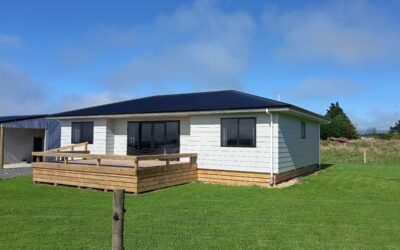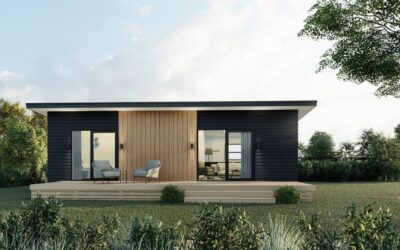Understanding the Differences: Modular, Transportable, Kitset, and Prefab Homes
When embarking on your prefabricated home journey, there are several options to consider. While modular, transportable, kitset, and prefab homes are often perceived as being one in the same, they each have distinct differences and unique benefits.
Check out what sets these homes apart and what you need to consider before starting your prefabricated home journey.
Modular
Modular homes are constructed in sections, or modules, within a controlled factory environment. Each module is built to exacting specifications and designed to fit together seamlessly once transported to the building site. The primary advantages of modular homes include speed of construction, quality control, and cost-effectiveness.
Because modular homes are built in a factory, weather conditions do not cause delays. Construction can proceed quickly and efficiently, often reducing the overall build time by up to 50% compared to traditional on-site building methods. Building in a factory setting allows for rigorous quality control measures. Every module is inspected throughout the construction process, ensuring consistent quality and adherence to building codes and standards.
The efficiency of factory construction often translates to lower costs. Additionally, bulk purchasing of materials can further reduce expenses, making modular homes a more affordable option for many buyers.
Modular homes are customisable, offering a range of design options to suit individual tastes. Once the modules are transported to the site, they are assembled on a permanent foundation, creating a home that is indistinguishable from traditionally built houses.
Transportable homes
Transportable homes refer to two different types of prefabricated homes.
The first being relocatable or mobile homes which are designed to be moved from one located to another. These types of homes are typically constructed on a chassis which allows them to be easily transported and set up in different locations.
The second type of transportable home are built in an offsite manufacturing facility (similar to a modular home build) then transported to your site as a completed home via road transporter. Once transported to your site, they can be quickly connected to utilities and made ready for occupancy.
Transportable homes are often more affordable than traditional homes thanks to their offsite manufacturing. Like modular homes, transportable homes are built in a controlled environment, allowing for faster construction times.
While transportable homes offer many benefits, they may also come with certain limitations. For example, they may be subject to restrictions on where they can be placed, may be limited due to accessibility to your site and although still highly customisable, they can have less design options available when compared to a bespoke architecturally designed home.
Kitset homes
Kitset homes are prefabricated structures that are delivered to the building site as a complete package of pre-cut materials. Homeowners or builders then assemble the home on-site according to detailed plans and instructions.
One of the main attractions of kitset homes is the potential for do-it-yourself construction. For those with construction skills, this can be a rewarding and cost-saving option. Kitset homes offer a high degree of customisation. Buyers can choose from various designs and layouts, and modifications can often be made to suit specific needs and preferences.
Kitset homes can be more affordable than traditional homes due to the reduced labour costs associated with on-site assembly. Buyers can also manage their budget by choosing how much of the work they wish to undertake themselves versus hiring professionals. However, kitset homes require a significant amount of time and effort to assemble, and the quality of the finished product can vary depending on the skill level of the builder.
Prefabricated Homes
Prefabricated, or prefab, homes is an umbrella term that encompasses various types of factory-built housing, including modular, transportable, and kitset homes. The key characteristic of prefab homes is that significant portions of the construction process occurs off-site in a controlled environment.
Prefab homes benefit from the efficiencies of factory construction, including reduced waste, shorter build times, and consistent quality control. The term “prefab” includes a wide range of building styles and methods, from fully finished modular homes to partially assembled kit homes. This variety allows buyers to choose the type of prefab home that best suits their needs and budget.
Choosing the right type of home construction method is a significant decision that depends on various factors, including budget, location, lifestyle, and personal preferences. Understanding the differences between the various construction methods can help you choose the right type of home for your specific needs, budget, and preferences. Whether you prioritise speed, flexibility, cost savings, or sustainability, there’s a modern construction method that can make your dream home a reality. Ultimately, these innovative housing solutions are revolutionising the industry, providing sustainable and creative alternatives for the future of residential construction.
Ezyline Homes are experts in the construction and delivery of transportable homes which utilise offsite manufacturing methods, delivering you a completed home to your site. Keen to find out more about the Ezyline difference and how we can help bring your transportable home dreams to life? Get in touch today to speak to our friendly team.
Check out some more helpful blogs below
Why a Transportable Home is the Perfect Farm Accommodation
Farmers and rural property owners often face the challenge of providing comfortable, cost-effective accommodation for workers, family members, or guests. A transportable home from Ezyline Homes is an ideal solution for farm accommodation, offering...
Benefits of an Offsite Build
In recent years, transportable homes have gained popularity as a cost-effective, high-quality, and customisable housing solution. With rising property prices and increasing demand for sustainable living, more people are discovering the benefits of...
Future-Proofing Your Granny Flat for Accessibility
As the demand for accessible housing continues to grow, future-proofing your transportable home ensures that it remains functional, comfortable, and adaptable for all stages of life. Whether for aging in place, accommodating family members with...
Keep up-to-date with what’s happening at Ezyline Homes, as well as relevant industry news.
Frequently asked questions (FAQs)
What is the difference between an Ezyline home and a tiny home/pod home?
Tiny/pod homes are typically much smaller in size. They are typically constructed of panels of various types including polystyrene and metal skin panels. They have a distinct shipping container look to them. Ezyline homes start at 50m² and are more traditional in their design.
How does a prefab/prebuilt or modular home differ from a traditionally constructed home that is built onsite?
Prefab/prebuilt or modular homes differ from traditionally constructed homes because they are constructed in an offsite manufacturing facility and then transported to your site either fully assembled, in sections or modules, or as a kit so that it is then assembled on your site.
Depending on the type of prefab/prebuilt or modular homes you chose, many of the same materials are used in construction of the home as one built onsite.
Prefab/prebuilt or modular homes often have a timber floor construction. Traditionally constructed homes are built onsite from the ground up and often with a concrete foundation and concrete floor slab.
Find out more about the various prefabricated construction methods in our recent blog.
Can you help with tight, steep difficult sections?
Yes, with our trusted network of professionals we can view the site and give our recommendations.
Ready to take the next step?
Stay in the loop
Keep up to date with what’s happening at Ezyline Homes



